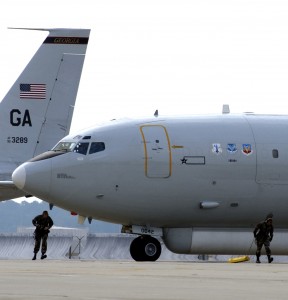JSTARS test plane revived, but has little to test
The Air Force hasn't found the money to modernize or replace its 1990s-era Joint Surveillance Target Attack Radar System planes, but a small consolation prize could be coming. Congress is poised to add up to $10 million to the 2014 budget to keep the fleet’s test plane flying out of Melbourne International Airport, Fla. The Air Force and prime contractor Northrop Grumman maintain a team there to try out new equipment before it's installed throughout the fleet.
Sen. Saxby Chambliss, R-Georgia, convinced the Senate Armed Services Committee to add $9.9 million to the White House budget request to keep the test plane, known as T-3, flying through 2014. His state is home to the Air Force wings that operate JSTARS.
“Senator Chambliss sees a valid requirement to retain the T-3 test aircraft in service,” spokeswoman Lauren Claffey said by email.
The House Appropriations Committee does too. Its version of the 2014 defense bill provides $10 million for the same purpose.
There’s just one problem. With no modernization work on the books for 2014, there won’t be much to test aside from minor software upgrades. That’s why the Air Force figured it should put the test plane in storage for a year while it sorted out the fleet’s future, an Air Force official said.
Backers worry that if T-3 is put in storage they might never get it back. With continued flights, they wouldn’t have the stress of reassembling a team of test experts if modernization work is funded, and in the meantime they wouldn’t have to divert any of the fleet’s 16 operational planes to try out each new minor piece of software.
As it stands, the Air Force plans to keep flying the JSTARS planes into the 2020s. An Air Force analysis of alternatives suggested replacing them with a version built on a fuel-efficient business jet airframe, but the Air Force says it can't afford that option. "We simply do not have the resources," then-Air Force Secretary Michael Donley told Chambliss at a hearing last month.
Advocates have a long list of modernization work they’d like to see done on JSTARS short of a new fleet. At a minimum, the fleet’s avionics will need upgrading so the planes aren't banned from international airspace, an Air Force official said.
The JSTARS planes have an interesting history. They were built to bounce radar signals off the ground to find tanks and trucks racing across conventional battlefields. The planes detect the Doppler shifts from moving objects and display the locations of those objects as dots on digital maps. Commanders on the planes or on the ground can quickly decide where to move their forces and when to order strikes. That's called battle management. In Afghanistan, the planes have been used in intelligence roles, for example, to map patterns of life on roadways. More recently, advocates have been pushing JSTARS into new roles such as maritime surveillance.
The planes often do intelligence work, but they are not funded under the country's $50 billion Military Intelligence Program.




Southeast Asia Maritime mission. Spratly Islands.
Consolidate the myriad radar applications directed at IED threats on a single, long-endurance, safe-standoff platform instead of the dozens of low endurance unique air platforms recently utilized.
Facing the conventional force-on-force engagements that JSTARS was built for seems remotely possible … IEDs, however, are the wave of the future for the next 100 years. … The last question to answer is how much money this will save(?)… See GAO report 12-861-R to find out why no one knows how much money this save
For IED Route Clearance, a better investment might be in Airborne Reconnaissance Low technology. Doesn’t have the range of JSTARS, but may be more cost effective and maneuverable along major supply routes. Not to say there is not a place for JSTARS, if ever involved in another conventional war, the stand-off capabilities are far superior to ARL.
Air Sea Battle Operations in the Pacific Theatre is a role that the Nation is headed for in future operations. JSTARS has a unique ability to fulfill ISRC2 combination that support National goals. Besides, it’s extremely hard to place an IED in that AO.
Considering the recent demise of the LTA ISR initiatives (https://medium.com/war-is-boring/d3681ef945b2) against the apparent lack of interest from air Army or Air Force in the sort of ground/surface surveillance capabilities of JSTAR, one really has to wonder if senior leaders are cutting off noses to spite faces. Surely the last decade has proven the requirement for such capabilities?
Nothing else compares to the capabilities of the platform and what it can do. When applied properly, which means a mix, integration, and cross-cue with other assets, the results are outstanding. However, it is a constant battle to re-educate the force at large and both services, Army and Air Force, only see dollar signs and billets vs. a tried and true system that is adaptable and flexible to support Unified Land Operations and Home Land Security operations, which the jet has proven it can and continues to do with significant results.
How can the USAF ignore the direction of congress to re engine JSTARS? Engine testing has been complete for several years and FAA type certificate issued and still no engines on the fleet. What gives? The savings that could have been made over the last several years could have paid back the investment in short order ( not to mention expand the capability of the fleet).